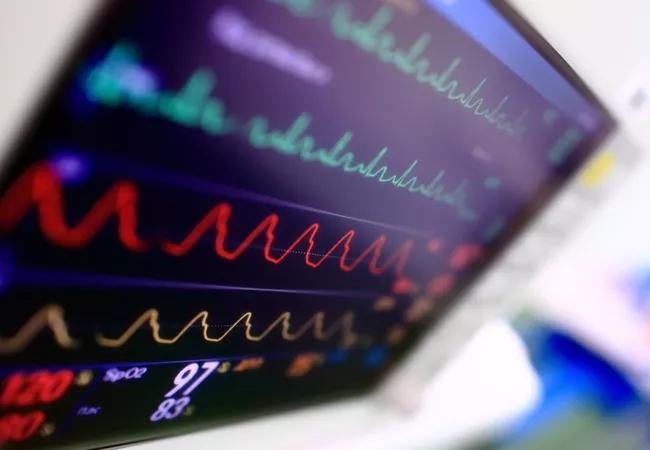Study supports telemetry as “no touch” alternative to 12-lead ECG

Cleveland Clinic researchers have validated the use of remote cardiac telemetry as a “no touch” alternative to standard 12-lead ECG for accurate continuous monitoring of patients’ QTc intervals. Their findings, which come from a two-part prospective investigation, are published in the Journal of Electrocardiology (2021;67:1-6).
Cleveland Clinic is a non-profit academic medical center. Advertising on our site helps support our mission. We do not endorse non-Cleveland Clinic products or services. Policy
“Because 12-lead ECG requires direct contact between caregivers and patients, its use for in-hospital QTc monitoring has not been optimal during the COVID-19 pandemic,” says the study’s senior author, Umesh Khot, MD, Head of Regional Cardiovascular Medicine at Cleveland Clinic. “In view of cardiac telemetry’s continuous monitoring capability and ubiquity in hospitals around the world, we believed it held strong potential for reducing infectious risk during the pandemic, but its use for QTc monitoring in this context had not been validated or implemented. We undertook this study in an effort to change that.”
He and his Cleveland Clinic colleagues designed their investigation in two stages — validation and implementation — with two separate cohorts.
In the study’s validation component, real-time cardiac telemetry was used for QTc interval measurement and compared with standard 12-lead ECG measurement. Over a five-day period in May 2020, 65 patients hospitalized at a Cleveland Clinic regional hospital with a need for 12-lead ECG for any indication were identified at random.
All 65 patients had QTc intervals obtained via remote telemetry as assessed by three blinded operators, and these measures were compared with QTc values simultaneously derived from 12-lead ECG as independently assessed by two board-certified electrophysiologists.
The strength of linear correlation between the two methods was demonstrated by a Pearson correlation coefficient of 0.84, indicating high accuracy of telemetry-based QTc measurement. Additionally, the learning curve for using telemetry was shallow. Reproducibility and precision of QTc measurements via telemetry were reflected by high inter-rater reliability, with an intraclass correlation coefficient of 0.81.
Building on the validation findings, this component of the study used telemetry-based remote monitoring to compile serial QTc intervals from a cohort of 68 symptomatic hospitalized patients with COVID-19 who were being treated with combined hydroxychloroquine and azithromycin. These patients were chosen for study because of these medications’ known proarrhythmic effects.
“Although the use of these medications for COVID-19 has since fallen out of favor, studying these patients allowed us to gauge the utility of continuous QTc monitoring by telemetry in patients with COVID-19, who have longer baseline QTc intervals than the general population regardless of whether or not they are taking QTc-prolonging therapies,” explains Dr. Khot.
All 68 patients in the cohort had QTc values recorded at baseline and two hours after administration of each dose of the two drugs. These measurements showed a statistically significant increase from baseline in median QTc interval with treatment, which began as early as after the first dose and reached 15 milliseconds (interquartile range, –2 to 41) after the ninth dose (P = 0.002).
The authors note that this finding is consistent with results of earlier studies showing significant prolongation of the QTc interval in COVID-19 patients treated with hydroxychloroquine with or without azithromycin.
“Our findings give credence to the use of telemetry as a valid clinical tool for QTc monitoring in place of standard 12-lead ECG,” says study co-author Christine Tanaka-Esposito, MD, a Cleveland Clinic electrophysiologist. “This approach to monitoring can minimize direct patient contact and mitigate infectious risk among healthcare personnel and patients alike.”
The authors note that their experience raises the prospect of using cardiac telemetry as an alternative to serial 12-lead ECG for additional applications, including for anti-arrhythmic drug loading protocols, prediction of ventricular arrhythmias and advanced diagnostics “that can provide granular insight beyond mere static measurement of QTc.”
Moreover, the role of telemetry as an alternative to 12-lead ECG extends beyond the COVID-19 pandemic. “This no-touch approach to arrhythmia monitoring is highly useful in any situation where avoidance of patient contact is advised for reducing infectious risk,” observes study co-author Roy Chung, MD, a Cleveland Clinic electrophysiologist.

Patients report improved sense of smell and taste

Clinicians who are accustomed to uncertainty can do well by patients

Unique skin changes can occur after infection or vaccine

Cleveland Clinic analysis suggests that obtaining care for the virus might reveal a previously undiagnosed condition

As the pandemic evolves, rheumatologists must continue to be mindful of most vulnerable patients

Early results suggest positive outcomes from COVID-19 PrEP treatment

Could the virus have caused the condition or triggered previously undiagnosed disease?

Five categories of cutaneous abnormalities are associated with COVID-19